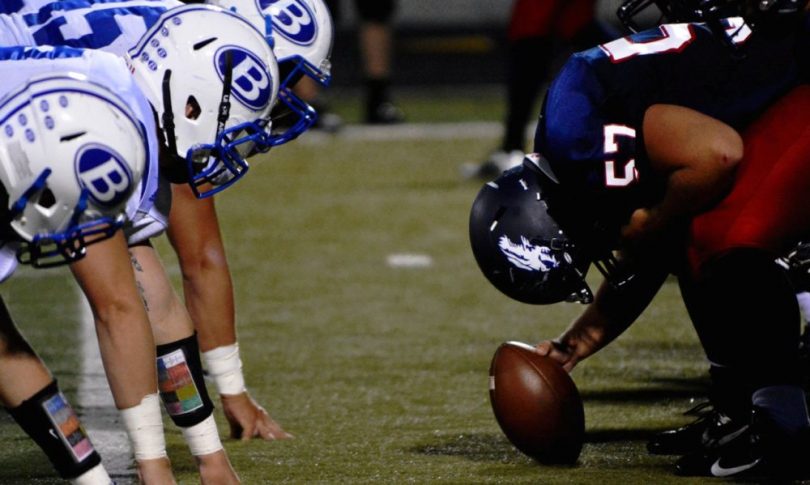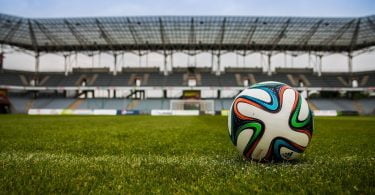In the few seconds that most plays in football last for, if you are a little unsure what is happening it can look extremely chaotic and will be tough to follow. With 22 players on the field doing different things football can be overwhelming, so here is a rookie’s guide to player positions to help you understand.
Before we get into this, the picture below that will be referred to throughout this article is used purely because it shows every major position in an offence and defence. Depending on teams, formations and plays, different players will be on the field at different times; for example, you might trade your fullback out for an extra wide receiver if you are planning a deep pass. We will start with the offence:

Centre
The Centre is a member of the offensive line and has the ball at the start of every play. To start the play, the centre snaps the ball through his legs to the quarterback behind him. He will then either stop defenders getting to the quarterback on a pass play or try to hit members of the defence out of the way to make gaps for a back to run the ball through.
Guard/Tackle
The guards and tackles on either side of the centre are the rest of the offensive line. They are big, physical players who have to protect whoever has the ball by blocking defenders, after starting lined up on the line of scrimmage.
Quarterback
The most important player in most NFL teams and leader of the offence, the quarterback will give everyone else their jobs in the huddle before a play starts, and receive the snap from the centre. The QB then has to throw a pass to a receiver, hand the ball off to a back who will run, or run himself if he needs to. Types of quarterback vary wildly, with traditional passers like Tom Brady and Aaron Rodgers having different playstyles to the athletic Cam Newton or agile Russell Wilson.
Fullback
In today’s american football games fullbacks do not tend to get much of the spotlight, they but they have to be versatile athletes. They can be asked to run the football, help the offensive line protect the quarterback, run ahead of the half back and block for him or catch passes. They will usually do more blocking than actually having the football in their hands.
Half back
Usually lining up a little further back from the line of scrimmage than the other backs, the half back’s primary role is to run the football and get first downs. Depending on the team they will also occasionally protect the QB, catch passes, or run play action fakes where the ball is pretended to be handed off to them in an effort to give the QB more time before he is tackled. Running back styles can vary, with many teams favouring the “thunder and lightning” approach with different backs. The Tennessee Titans are a good example of this, with the quick, agile Derrick Henry offering a different style to the strong, aggressive DeMarco Murray.
Tight End
Tight ends tend to be strong, versatile players who line up either close to the offensive line or as an extra member of it. They will either help the line block defenders or run routes and catch passes. The New England Patriots often have two tight ends on the field and utilise them in a consistently impressive passing attack starring Rob Gronkowski.
Wide receiver
Wide receivers generally have one job: run the route they are told to, find some space on the field and catch passes to get as many yards and touchdowns as they can. They will also help block defenders on run plays, or run routes to throw the defence off in a play-action situation. The Jaguars boast an incredible bunch of receivers in Allen Robinson, Allen Hurns and Marquise Lee.
That accounts for the eleven men on the offensive side of the ball, so now let us look at the defence. Again, keep in mind there are many different styles of defence to the base 4-3 formation shown here.
Tackle/End
Although the jobs differ across the D-line, the players generally have one job, which is to get the man across from you out of your way and tackle whoever has the ball. Defensive Tackles (often referred to as nose tackles) tend to be more focused on not allowing holes to open up for runners, whereas defensive ends are more out and out players who are aiming to hit the quarterback.
Linebackers
By far the most versatile players on the defence, linebackers are asked to tackle runners, blitz and go after the quarterback, block passes, and cover tight ends. Middle LBs tend to be the bigger players who have always got an eye on the running back, while outside linebackers tend to be more pass-defence-orientated. They are quick enough to get to the QB or whoever he is throwing to. The Carolina Panthers boast a scary linebacker group led by Luke Kuechley.
Cornerbacks
Cornerbacks match up against wide receivers and their primary role is to stop WRs catching passes by blocking the ball or catching it themselves, or making sure they tackle the receivers after the catch. Cornerbacks need to be quick and competitive to keep up with receivers throughout the game.
Safeties
Along with cornerbacks, safeties make up the defensive backs group, and as their name might suggest they are basically insurance for when an offensive player gets the better of his defensive matchup. Safeties will not start trying to make a play until a second or two after the ball is snapped so they can better read what the offence is doing, and will often make important tackles and interceptions. Seahawks safeties Kam Chancellor and Earl Thomas are probably the best duo in the league.
So now, next time you are watching a game you will be able to pick out who everyone is before the play starts and will have a better idea of what is going on. Make sure you check out our other rookie’s guides, and get excited for the season start on 8th September.









